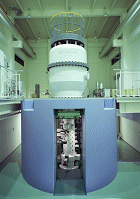Quantum Measurement
Published in "Nature", Vol.412, No.6847, pp.620-622: A. Tonomura et al.
(http://www.nature.com)
The columnar defects in high-temperature superconductors produced by heavy-ion irradiation are considered to be the most suitable pinning centers for macroscopic investigations. In particular, when a vortex is entirely trapped along a thin column, it is expected to be strongly pinned. However, direct observation of this effect has not been possible up to now. Here, we report the first direct observation by Lorentz microscopy of the interaction between vortices and columnar defects in ion-irradiated Bi2Sr2CaCu2O8+δ (Bi-2212) thin films by using our newly-developed 1-MV field-emission electron microscope. We have observed diverse dynamical behaviors of vortex lines at various temperatures, in addition to static behaviors of trapped vortex lines and untrapped vortex lines at columnar defects. Some typical behaviors of these vortex lines are shown in the following movies.
This work was performed in collaboration with Univ. of Tokyo, CREST and SORST of Japan Science and Technology Corporation (JST), and Japan Atomic Energy Research Institute.
1. 1-MV field-emission electron microscope (1 min 5 sec)

The University of Tokyo and Hitachi Advanced Research Laboratory have developed a new-generation ultra-high-voltage electron microscope with the support of the Core Research for Evolutional Science and Technology (CREST) program of the Japan Science and Technology Corporation (JST). This new 1-MV holography electron microscope uses the wave property of electrons to make electric and magnetic field observations with atomic resolution, to investigate the foundation of quantum phenomena, and to explore the structure and function of bio-molecules. With these capabilities, the 1-MV holography electron microscope promises to lead us into the next industrial revolution through fundamental advances in our understanding of science.
(This video clip is a part of "Toward the Pico-World ---Challenge for the 1MV Holography Electron Microscope---",
planned by Hitachi, Ltd., cooperation by Japan Science and Technology Corporation, and produced by Image Science, Inc.)
2. Temperature dependence (11 sec)
Tilt angle of vortices change with temperature. At temperatures lower than 12 K, trapped vortices at columnar defects are perpendicular to the film plane. With the increase in temperature, the trapped vortices begin to tilt along the column and the contrast in the movie decreases. The arrows indicate the same vortices at deferent temperatures.
3. Migration (7 sec)
Migration speed increases with temperature. At 16 K, some vortices are trapped at the defects, while others migrate and pass around the trapped vortices.
4. Migration/stop (6 sec)
Migration speed increases with temperature. At 16 K, some vortices are trapped at the defects, while others migrate and pass around the trapped vortices.
5. Hopping (7 sec)
At temperatures higher than 25 K and at low vortex density, vortices hop from one defect to another.